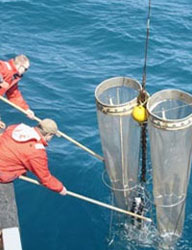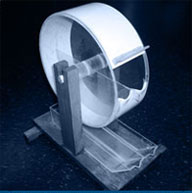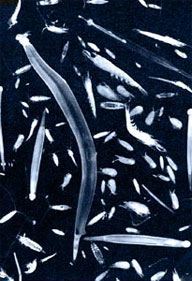Zooplankton Sampling

The sampling strategy adopted depends on the purpose of the study. Sampling can be:
- Qualitative, in which case the main objective might be to obtain a rapid picture of species present, perhaps to document seasonal changes or to predict blooms of harmful jellyfish.
- Quantitative, in which case the objective might be to determine whether the abundance of harmful species is increasing or decreasing.
In both cases the sampling equipment would be a plankton net, usually made from monofilament nylon mesh. Mesh size can vary from 50 µm to 300 µm. Mesh opening will determine the size of the organisms retained so nets are selective to some degree. Fine mesh nets will clog quickly, can only be towed slowly, and faster moving zooplankton will detect their approach and avoid them.
Coarse mesh nets, on the other hand, will allow many of the smaller size classes to pass through.
Commonly, a 200 µm mesh or larger is used in temperate regions, but a smaller mesh size, such as 70-100 µm is used to sample the smaller zooplankton in the tropics. Nets can either be towed horizontally from a boat or pulled vertically from a fixed platform. When the net is hauled to the surface the plankton accumulates in the codend, a removable container that can be emptied into a screw-topped jar for storage.

Within Australia suitable conical nets can be obtained from:
IMBROS - Technology for Laboratory and Marine Science
1059 Cambridge Road
CAMBRIDGE TAS 7170
Phone: +61 3 6216 1500
Fax: +61 3 6216 1555
Email: Imbros
Alternatively, the following companies will sew up a net to your specifications if the material is provided (Australian Filter Specialists can provide the filter mesh):
Industrial Sewing Specialists
PO Box 519
KINGSTON TAS 7051

Australian Filter Specialists
Unit 10/25-41 Redwood Drive
DINGLEY VIC 3172
Quantitative sampling needs some means of measuring the quantity of water that passes through the net or at least ensuring that hauls are made in as standard a way as possible, for example, by hauling the net, for the same length of time, at the same speed, and either with or against a prevailing current. Sampling at the same time of day (or night) is necessary too, given that many planktonic animals undergo vertical migration.
There are instruments that record the distance travelled by the net and this value, together with mouth area, can be converted into volume of water filtered. But in most cases it is sufficient to maintain constant conditions so that numbers of a particular species in one haul can be compared validly to numbers in another.
Zooplankton are fascinating to watch while alive but, because most are quite small, they are best viewed under a stereo microscope. However, for identification and counting they must be preserved either in 4% formaldehyde (buffered with borax ~2.5 g per 100 ml of concentrated formalin) or 3% glutaraldehyde (buffered with phosphate buffer).
These chemicals are readily available through scientific supply companies. Formaldehyde (known as formalin when in solution) is highly toxic, has an unpleasant pungent smell and is a suspected carcinogen.
It is advisable to transfer organisms from formaldehyde to 70% alcohol after about a day and before starting sorting and identification. Animals can be stored long term in alcohol, if necessary, after prior fixing in formaldehyde.
If samples are particularly large, the catch can be split into two equal halves using a Folsom plankton splitter.

